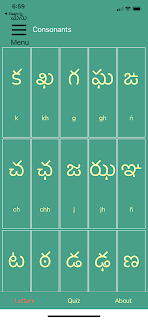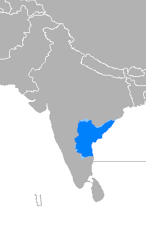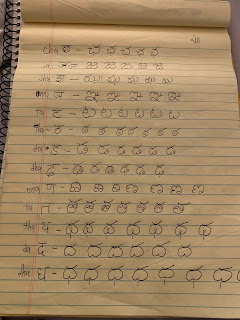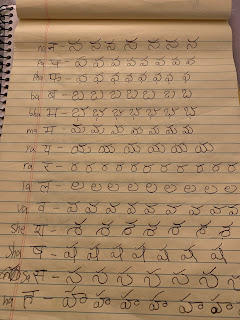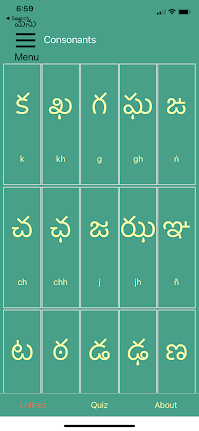About Telugu عن اللغة التيلوغوية
What is Telugu? Telugu is a language of southern India, mainly spoken in the states of Andra Pradesh and Telangana, with huge diasporas all over the world and especially in the United States. Although it's not in our top 10 languages here, it is considered by some estimates the fastest growing language in the country.
ما هي التيلوغوية؟ هي لغة من جنوب الهند يتمركز متكلميها في ولايتي اندهرا برديش وتيلانغانا وشتاتهم ضخم في كل أنحاء العالم وخصوصا في الولايات المتحدة.
ربما يكون خارج إطار "لسانيات شمال أفريقيا" أني اكتب أحد أول بوستاتي عن لغة هندية جنوبية ولكن التيلوغوية تضل على بالي كثيرا هذه الأيام بسبب إحدى أقرب أصدقائي وقد ما أنا أهتم باللغات المهمشة فهي تهتم بالديانات وسمات أخرى لتلك الثقافات. منذ بداية صداقتنا وهي تحاول أن تعلمني لغتها هذه لكن التقدم بطيء ويرجع ذلك جزئيا إلى نقص المواد. يمثل الخط حاجزا كبيرا كذلك. حيث أنها متكلمة "تراثية" للغة وتربت هنا في ولايات المتحدة فهي تجد صعوبة في قرائته أيضا ولذا فمعظم الوقت نتكلم اللغة معا فقط مع أن لغتي تقتصر على جمل مثل "أين الكلب؟ أنا احب اكل الدوسات." كُكّا ايكَّرا؟ نكو دوسالو اشتم.
Telugu is a Dravidian language, belonging to a family of languages mainly spoken in South India. Other major languages of the family include Tamil, Malayalam, and Kannada. Dravidian languages apparently don't natively distinguish the aspirated and unaspirated stops that North Indian languages are well known for. Telugu apparently does make this distinction but mostly for Sanskrit and Prakrit loanwords, which are apparently a huge chunk of the lexicon. These loans are called Tatsamas and are usually used for high-register language, a bit like latinate words in English and Fus7a in "cultured" colloquial Arabic. There is even some Perso-Arabic influence on some varieties of Telugu, especially in Telengana and Hyderabad due to centuries of Turkic rule and influence from the Urdu-speaking Muslims of Hyderabad.
التيلوغوية هي لغة درافيدية فهي تنتمي إلى عائلة لغوية يُتحدث بها رئيسيا في جنوب الهند ولغات كبيرة أخرى في هذه العائلة التاميلية والماليالامية والكنادية. على ما يبدو لغات هذه العائلة عادة لا تميز بين الصوامت الزافرة وغير الزافرة الأمر الذي تشتهر به لغات شمال الهند. على ما يبدو فالتيلوغية فعلا تميز بينها ولكنها غالبا ما تظهر في الكلمات المتعرضة من السنسكريتية والپركرتية وعلى ما يبدو فهي جزء كبير من المعجم. تسمى تلك الكلمات المستعرضة "تاتساما" وعادة تُستخدم في سجل لغوي عالي وهذا يشبه قليلا استخدام كلمات من أصل لاتيني بالانجليزية والفصحى في عامية المثقفين. يوجد حتى بعض التأثر الفارسي-عربي على بعض اللهجات التيلوغوية وخصوصا في ولاية تيلينغانا ومدينة حيدر اباد نظر لقرون من السيادة التوركية وتأثير متكلمي الأردو المسلمين في حيدر اباد.
تثير قواعد التيلوغية الاهتمام كذلك ولديها ثلالثة أجناس وهم المذكر والمؤنث والمحايد لكن المذكر والمؤنث يشيران قفط إلى مشار إليهم من البشر فهي ليست كاللغات الرومانسية حيث تستطيع الطاولة أن تكون مؤنثة. لديها ٨ حالات نحوية وتُضاف لاسم الجمع اللاحقة "لو" التي تخدم وظيفة الدلع حيث تضاف للأسماء فمثلا كلب صديقتي اسمه "پيني" فأحيانا ندلعه "پينيلو." تمزح صديقتي أحيانا أن التيلوغوية مثل الإياطالية الخاصة بالهند أو ربما أن تكون الإيطالية التيلوغوية الخاصة بأوروبا. أعتقد أن هذا لأنهما لديهما الكثير من المقاطع من صيغة (صامت+صائت) ويميزان بين الحروف المشدة وغير المشدة مع أن جردي صوائتهما يختلفان قليلا فالتيلوغوية لها ٥ صوائت وتميز بين الصائت القصير والطويل والإياطالية لها ٧ صوائت. يوجد نوعي ضمير المتكلمين وهما ما يشير إلى المخاطب كذلك (الشامل) وما لا يشير إليك (غير الشامل) وهما مانامّو وميمو ودائما ما أتخيل أن هذا الأمر يوضح لو كنت معزوم ام لا لما واحد صاحبك بيقولك مثلا "احنى رايحين حفلة بعدين." لدى أسماء الإشارة صرف للأجناس الثلاثة ولدى المذكر والمؤنث ٤ مستويات للرسمية.
The script is really interesting. It's an alpha-syllabary with a lot of round letters, and my impression has been that it takes a long time to write a single letter (maybe I'm just not well-practiced enough yet) but it feels satisfying when it comes out looking nice.
إن الخط شيق جدا فهو أبوجيدا والكثير من الحروف شبه مدورة وانطباعي أنه يستغرق وقتا طويلا لكتابة حرفا واحدا (لكن ربما هذا لأني مازلت مبتدئ) لكنه احساس جميل لما يطلع شكله حلو.
I was frustrated trying to find an app for just learning and memorizing the letters (there's a lot of them! ~60 symbols to learn. And at first they all look the same), so I decided to just make my own (iOS version here).
كمت محبط وانا بحاول الاقي تطبييق بس عشان أحفظ الحروف (وهي كتيرة! حوالي ٦٠ شكل تحفظهم وفي الأول كلهم شبه بعض) فقررت اعمل تطبييق بنفسي (وهنا النسخة الخاص بأجهزة اپل)

